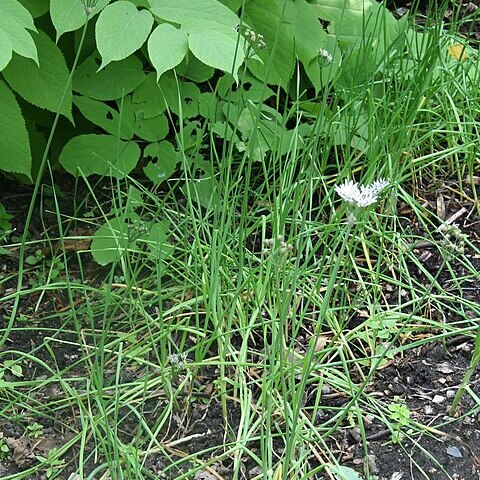Bulbs clustered, subcylindric; tunic dull yellow to yellowish brown, reticulate to subreticulate. Leaves linear, shorter than scape, 1.5--8 mm wide, 3-angled, 1-keeled abaxially, fistulose, margin and angles scabrous-denticulate or smooth. Scape 25--60 cm, terete, obscurely angled, covered with leaf sheaths only at base. Spathe 1-or 2-valved. Umbel hemispheric to subglobose, many flowered. Pedicels subequal, 2--4 × as long as perianth, bracteolate and several covered with a common bract at base. Perianth white, sometimes slightly tinged with pale red; segments with pale red midvein; outer ones oblong-ovate to oblong-lanceolate, usually slightly narrower than inner, (4.5--)5.5--9(--11) × 1.5--2.9 mm; inner ones oblong-obovate, (4.5--)5.5--9(--11) × 1.8--3.1 mm. Filaments narrowly triangular, equal, 1/2--3/4 as long as perianth segments, connate at base and adnate to perianth segments; inner ones slightly wider than outer at base. Ovary obconical-globose, minutely tuberculate, without concave nectaries at base. Fl. and fr. Jun--Sep. 2 n = 16*, 32*.
More
An onion family plant. It is a bulb plant. The bulbs occur in clusters. The skin is dull yellow to yellow brown. It has a netlike appearance. The leaves are narrow. They are 1.5-8 mm wide and 3 angled. The scape is 25-60 cm long. It is covered with the leaf sheaths only at the base. The flower head is half round. The flowers are white with red stripes.
Plain steppes or forest steppe belts, dry, alkaline meadows, stony hill slopes, waterside pebbles and other petrophytic communities. Sunny hills and pastures at elevations from 500-2,100 metres in northern China.
More
It is a temperate climate plant. It grows in sunny hill pastures between 500-2100 m altitude in N China.
Can be grown by divisions or seedlings. Seeds needs stratification.


